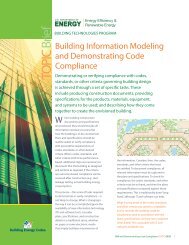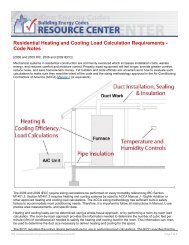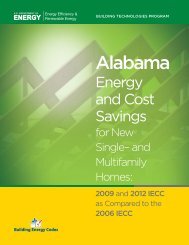Kitchen Exhaust - Building Energy Codes
Kitchen Exhaust - Building Energy Codes
Kitchen Exhaust - Building Energy Codes
You also want an ePaper? Increase the reach of your titles
YUMPU automatically turns print PDFs into web optimized ePapers that Google loves.
CODE NOTESANSI/ASHRAE/IES Standard 90.1-2010<strong>Kitchen</strong> <strong>Exhaust</strong> (Continued)Heat recovery options usually includecoils or a heat exchanger that extractsheat from kitchen exhaust and usesthe heat to preheat ventilation airor preheat service hot water. A heatrecovery system for a hood with greasyexhaust air requires a wash-down systemto automatically clean the coil, whichcontinually consumes detergent. HeatDemand ventilation system (DVS): Asystem that includes controls that sensetemperature and smoke under the hoodand vary the exhaust and makeup fanspeeds to maintain safe and effectivekitchen exhaust both in idle and fullcooking conditions.Demand control ventilation (DCV):A ventilation system capability thatprovides for the automatic reduction ofoutdoor air intake below design rateswhen the actual occupancy of spacesserved by the system is less than designoccupancy.Makeup air (dedicated replacement air):Outdoor air deliberately brought into thebuilding from the outside and suppliedto the vicinity of an exhaust hood toreplace air, vapor, and contaminants beingexhausted. Makeup air is generally filteredand fan-forced, and it may be heated orDefinitions 1recovery systems are less expensive foroven and other hoods where greasecleaning is not necessary. To qualify, theheat recovery device must be listed witha heat recovery effectiveness of 40%. Inmost cases, a DVS is preferred over heatrecovery units because of initial cost andongoing maintenance costs.cooled depending on the requirementsof the application. Makeup air may bedelivered through outlets integral to theexhaust hood or through outlets in thesame room.Replacement air: Outdoor air that is usedto replace air removed from a buildingthrough an exhaust system. Replacementair may be derived from one or moreof the following: makeup air, supply air,transfer air, and infiltration. However,the ultimate source of all replacementair is outdoor air. When replacement airexceeds exhaust, the result is exfiltration.Transfer air: Air transferred from oneroom to another through openings in theroom envelope, whether it is transferredintentionally or not. The driving force fortransfer air is generally a small pressuredifferential between the rooms, althoughone or more fans may be used.1 Demand control ventilation, makeup air, replacement air, and transfer air definitions from ASHRAE Standard 90.1-2010.2
ANSI/ASHRAE/IES Standard 90.1-2010<strong>Kitchen</strong> <strong>Exhaust</strong> (Continued)In Example C, the designer has chosen to supply more than 50% of replacement airwith transfer air, and can meet the entire replacement air requirement with transfer air,eliminating the need for a kitchen makeup air unit. A lower minimum outside airflowcould be selected for the dining room, and a makeup air unit would be needed in thekitchen. Meeting at least 50% of the kitchen exhaust replacement requirement withtransfer air means that a DVS is not required.Example C. <strong>Kitchen</strong> hoods total more than 5,000 cfm; more than 50% transfer air; kitchen exhaust demandventilation system not required. In this example, the designer could choose to have the dining room supplyminimum lower, but as long as available transfer air is more than 50% of kitchen exhaust, a kitchen exhaustdemand ventilation system would not be required.In Example D for the same kitchen and adjacent space situation, the designer hasreduced the minimum dining outside air and chosen to include a makeup air unitand DVSs on two of the hoods. Based on the current language and definition ofDCV, either approach would comply with both Section 6.4.3.9 (see separate DemandControlled Ventilation Code Note 2 ) and Section 6.5.7.1 of ASHRAE Standard 90.1-2010Note that the DCV is a mandatory requirement, and some reduction of ventilation airin the dining spaces must be included, while the kitchen ventilation requirement isprescriptive and the savings generated can be traded off with another energy savingstrategy using the performance approach in Section 11 of ASHRAE Standard 90.1-2010.Example D. <strong>Kitchen</strong> hoods total more than 5,000 cfm. In this example, the designer could choose to have thedining room supply minimum at 2,500 cfm, and then transfer air would be less than 50% of kitchen exhaustand a demand ventilation system would be required.2 U.S. Department of <strong>Energy</strong>, <strong>Building</strong> <strong>Energy</strong> <strong>Codes</strong> Program. 2012. “Demand Controlled Ventilation – Code Notes,”<strong>Building</strong> <strong>Energy</strong> <strong>Codes</strong> Resource Center, Article ????. U.S. Department of <strong>Energy</strong>, Washington, D.C. Available online at:www.energycodes.gov/help/notes.stm5
ANSI/ASHRAE/IES Standard 90.1-2010<strong>Kitchen</strong> <strong>Exhaust</strong> (Continued)Example E shows the case when adjacent spaces are served by variable air volume(VAV) reheat systems. In this case, increasing the zone minimum airflow above thatrequired for ventilation will likely require more use of reheat; so, unlike Example C,providing more transfer air is inefficient and inappropriate. An appropriateinterpretation when transfer air is coming from VAV reheat systems would be torequire no more “available transfer air” be considered for makeup air unit sizing thanthe lowest airflow setpoint on the VAV boxes under DCV control. This means that lessthan 50% of replacement air is coming from transfer air, resulting in a requirementfor DVSs or heat recovery. For the hoods, DVSs will likely be installed because theyare less expensive than heat recovery options, especially in hoods that have greasyexhaust air. To properly control kitchen pressure relationships to adjacent spaces, itis best to maintain a constant minimum VAV box and transfer airflow so that kitchenexhaust can be properly balanced dynamically with the makeup air unit. Moreadvanced control strategies may use pressure controls to adapt the makeup air unitairflow to variable transfer air as dining and lobby airflows adjust based on DCV andcomfort requirements.Example E. <strong>Kitchen</strong> hoods total more than 5,000 cfm; less than 50% transfer air so kitchen exhaust demandventilation system is required.6
ANSI/ASHRAE/IES Standard 90.1-2010<strong>Kitchen</strong> <strong>Exhaust</strong>Verify Maximum Hood Airflow is Not ExceededStep Reference Criteria3a 2a:If total hood airflow [2a] does not exceed 5,000 cfm, hood airflowlimits are met.Determination(Y/N)3b 2h: If actual transfer percentage [2h] is at least 75%, hood airflow limits are met.3c-3f3gIf either of the above is true, skip to step 4.If neither of the above is true, then return to the “<strong>Kitchen</strong> Hood Working Table” and completesteps 3c through 3f.[1a] ≤ [3f]Check that each hood’s airflow [1a] on the the “<strong>Kitchen</strong> Hood Working Table”does not exceed maximum allowed airflow [3f].<strong>Kitchen</strong> <strong>Exhaust</strong> <strong>Energy</strong> Efficiency DeterminationStep Reference Criteria4a 2a:If total hood airflow (2a) does not exceed 5,000 cfm, efficiency requirementsare met.Determination(Y/N)4b 2h:If actual transfer percentage (2h) is 50% or more, efficiency requirementsare met.If one of the above is not true, then one of the following (4c or 4d) must be met:4c.i Total hood airflow with demand ventilation systems that reduce airflow by 50%4c.ii Percentage airflow with DVS ( [4c.i] / [2c] )4c.iii4d.iIf 4c.ii is greater than 75%, efficiency requirements are met.Total hood airflow with energy recovery systems with a sensible heat recoveryeffectiveness of 40% or more4d.ii Percentage airflow with heat recovery ( [4d.i] / [2c] )4d.iiiIf 4d.ii is at least 50%, efficiency requirements are met.For more information, visit:http://www1.eere.energy.gov/buildings/PNNL-SA-89860 • August 2012Printed with a renewable-source ink on paper containing at least 50% wastepaper, including 10% post consumer waste.ANSI/ASHRAE/IES Standard 90.1 <strong>Kitchen</strong> <strong>Exhaust</strong> 14
















